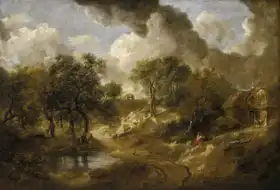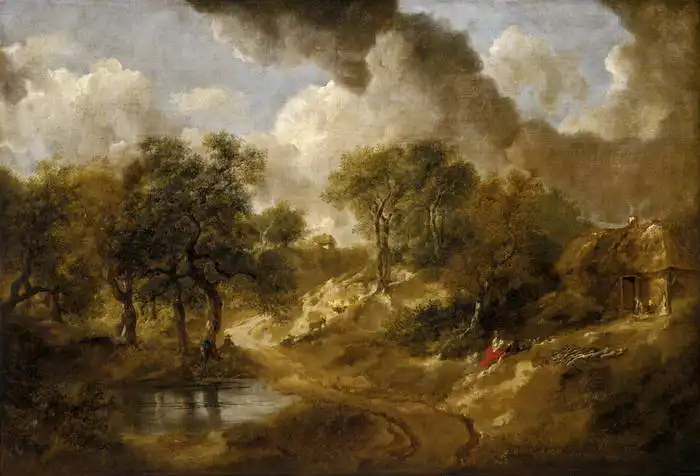About this finishing
Print. The image is printed on the top quality 10-ink HP Z9PS printer on HP matte 270 g / m2 paper. You can choose any size to an accuracy of 1 cm. A margin of 5 cm around the image is added to the size of the motif.


You can find a detailed description about our finishings
here.
Landscape in Suffolk
The painting depicts an idyllic landscape, probably from the 17th or 18th century. It shows a path leading downhill to a small lake surrounded by trees. A small cottage with a thatched roof can be seen in the left background. A dramatic overcast sky looms over the scene, suggesting the possible aftermath of rain or the arrival of a storm. In front of the cottage a small figure in red clothing can be seen, while a second figure stands by the road closer to the viewer.
This description was created by artificial intelligence, please be indulgent.
Prevailing color of this fine art print is brown and its shape is landscape. This image is printed on demand - you can choose material, size and finishing.
Thomas Gainsborough (1727-1788) was the leader of
Romanticism in England. He came from a family of weavers. Like him, his brothers were talented in various fields. For example, his brother Humphrey was involved in the method of steam condensation in a special vessel at the Faculty of Mechanics. James Watt later drew on this project. Thomas himself studied art in London. He married and supported his family by selling his landscapes. However, at that time, despite their distinctive character, they did not sell very well. Therefore, he returned to his native Sudbury in Sulffolk, where he painted portraits, such as immortalizing the unknown
Officer of the 4th Infantry Regiment. After several years, he moved with his family to Bath, where he examined the technique of
van Dyck. He began painting portraits of famous and influential people for exhibitions, which brought him national fame. He was finally invited to become a founding member of the Royal Academy in 1769. He was doing well and could move to London, where he continued to paint portraits for the next 10 years. The turning point came in 1780, when he was commissioned by King George III. This also caused an improvement in his relations at the Royal Academy. Despite remaining a favourite royal painter, he retreated to peaceful landscapes in old age. At the age of 61, he died of cancer and was buried in the Church of St. Anna. His paintings today are much valued at auctions and are auctioned for exorbitant amounts.


